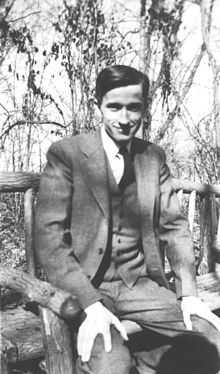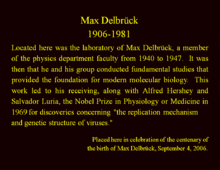Max Delbrück
| Max Delbrück | |
|---|---|
 Delbrück in the early 1940s | |
| Born |
Max Ludwig Henning Delbrück September 4, 1906 Berlin, German Empire |
| Died |
March 9, 1981 (aged 74) Pasadena, California, United States |
| Citizenship | United States[1] |
| Fields | Biophysics |
| Known for | "discoveries concerning the replication mechanism and the genetic structure of viruses" (Nobel Committee)[2] |
| Notable awards |
Nobel Prize in Physiology or Medicine 1969 Royal Society – Elected Foreign Member (8 Annually[3]) 1967 |
Max Ludwig Henning Delbrück, FRS[4] (September 4, 1906 – March 9, 1981), a German–American biophysicist, helped launch the molecular biology research program in the late 1930s. He stimulated physical scientists' interest into biology, especially as to basic research to physically explain genes, mysterious at the time. Formed in 1945 and led by Delbrück along with Salvador Luria and Alfred Hershey, the Phage Group made substantial headway unraveling important aspects of cell physiology. The three shared the 1969 Nobel Prize in Physiology or Medicine "for their discoveries concerning the replication mechanism and the genetic structure of viruses".[5]
He was the first physicist to predict what is now called Delbrück scattering.
Early and personal life
Delbrück was born in Berlin, German Empire. His mother was granddaughter of Justus von Liebig, eminent chemist, while his father Hans Delbrück was a history professor at the University of Berlin. In 1937, Max left Nazi Germany for America—first California, then Tennessee—becoming a US citizen in 1945.[1] In 1941, he married Mary Bruce. They had four children.
Delbrück's brother Justus, a lawyer, as well as his sister Emmi Bonhoeffer were active along with his brothers-in-law Klaus Bonhoeffer and Dietrich Bonhoeffer in resistance to Nazism. Found guilty by the People's Court for roles in the July 20, 1944 plot to assassinate Hitler, the three men were executed in 1945 by the RSHA.
Education and early career
Delbrück studied astrophysics, shifting towards theoretical physics, at the University of Göttingen. Having earned a Ph.D. in 1930, he traveled through England, Denmark, and Switzerland. He met Wolfgang Pauli and Niels Bohr, who interested him in biology.
Delbrück returned to Berlin in 1932 as an assistant to Lise Meitner, who was collaborating with Otto Hahn on irradiation of uranium with neutrons. Delbrück wrote a few papers, including one in 1933 on gamma rays' scattering by a Coulomb field's polarization of a vacuum. Though theoretically tenable, his conclusion was misplaced, whereas Hans Bethe some 20 years later confirmed the phenomenon and named it "Delbrück scattering".[6]
In 1937, he attained a fellowship from Rockefeller Foundation—which was launching the molecular biology research program—to research genetics of the fruit fly, Drosophila melanogaster, in California Institute of Technology's biology department,[7] where Delbrück could blend interests in biochemistry and genetics.[8] While at Caltech, Delbrück researched bacteria and their viruses (bacteriophages or phages). In 1939, with E.L. Ellis, he coauthored "The growth of bacteriophage", a paper reporting that the viruses reproduce in one step, not exponentially as do cellular organisms.
Role in biology research
Although Delbrück's Rockefeller Foundation fellowship expired in 1939, the Foundation matched him up with Vanderbilt University in Nashville, Tennessee, where from 1940 to 1947 he taught physics, yet had his laboratory in the biology department.[9] In 1941, Delbrück met Salvador Luria of Indiana University who began visiting Vanderbilt.[9] In 1942, Delbrück and Luria published on bacterial resistance to virus infection mediated by random mutation.[9] Alfred Hershey of Washington University began visiting in 1943.[9]
In 1945, Delbrück, Luria, and Hershey set up a course in bacteriophage genetics at Cold Spring Harbor Laboratory in Long Island, New York.[9] This Phage Group spurred molecular biology's early development.[10] Delbrück received the 1969 Nobel Prize in Physiology or Medicine, shared with Luria and Hershey.[5][9] Also that year, Delbrück and Luria were awarded by Columbia University the Louisa Gross Horwitz Prize. In late 1947, as Vanderbilt lacked the resources to keep him, Delbrück had returned to Caltech as a professor of biology, and remained there for the remaining duration of his career.[9] Meanwhile, he set up University of Cologne's institute for molecular genetics.
Later life and legacy

Delbrück helped spur physical scientists' interest in biology. His inferences on genes' susceptibility to mutation was relied on by physicist Erwin Schrödinger in his 1944 book What Is Life?,[12] which conjectured genes were an "aperiodic crystal" storing codescript and influenced Francis Crick and James D. Watson in their 1953 identification of cellular DNA's molecular structure as a double helix.[13][14] In 1977, he retired from Caltech, yet remained Professor of Biology emeritus.
Max Delbrück died, at age 74, on the evening of Monday, March 9, 1981, at Huntington Memorial Hospital in Pasadena, California. On August 26 to 27, 2006—the year Delbrück would have turned 100—family and friends gathered at Cold Spring Harbor Laboratory to reminisce on his life and work.[15] Although Delbrück supported research reductionism, he conjectured that ultimately a paradox—akin perhaps to the waveparticle duality of physics—would be revealed about life.[16]
See also
- Max Delbruck Prize, formerly known as the biological physics prize, awarded by the American Physical Society
- Saffman–Delbrück model
References
- ↑ 1.0 1.1 "Max Delbrück". Encyclopaedia Brittanica. Encyclopædia Britannica, Inc. Retrieved June 25, 2013.
A refugee from Nazi Germany, Delbrück went to the United States in 1937, serving as a faculty member of the California Institute of Technology (1937–39; 1947–81) and of Vanderbilt University (1940–47). He became a U.S. citizen in 1945.
- ↑ "The Nobel Prize in Physiology or Medicine 1969". Nobel Foundation. Archived from the original on June 25, 2013. Retrieved June 25, 2013.
- ↑ "Fellowship of the Royal Society (1660-)". Royal Society. Royal Society. Retrieved June 25, 2013.
- ↑ Hayes, W. (1982). "Max Ludwig Henning Delbruck. 4 September 1906-10 March 1981". Biographical Memoirs of Fellows of the Royal Society 28: 58–26. doi:10.1098/rsbm.1982.0003. JSTOR 769892. PMID 11639973.
- ↑ 5.0 5.1 "The Nobel Prize in Physiology or Medicine 1969", Nobel Media AB 2013, Nobelprize.org, Web acces November 6, 2013.
- ↑ Hayes W. "Max Ludwig Henning Delbrück—September 4, 1906-March 10, 1981". Biogr Mem Natl Acad Sci. 1992;62:67-117.
- ↑ "MDC celebrates centennial of Max Delbrück". Max Delbrück Center for Molecular Medicine Berli-Buch. September 4, 2006.
- ↑ Tapke, Stefanie. "Max Delbrück - Biographical". Biographical article. Nobel Media. Retrieved September 13, 2013.
- ↑ 9.0 9.1 9.2 9.3 9.4 9.5 9.6 "Max Delbrück at Vanderbilt, 1940–1947", Vanderbilt University, Web access November 6, 2013.
- ↑ Watson JD, "James D Watson: Chancellor emeritus", Cold Spring Harbor Laboratory, 2012.
- ↑ Max Delbrück and the Next 100 Years of Biology: The Max Delbrück Vanderbilt Centenary Celebration, The Inaugural Vanderbilt Discovery Lecture, Held September 14, 2006
- ↑ Dronamraju KR. "Erwin Schrödinger and the origins of molecular biology". Genetics. 1999 Nov;153(3):1071-6.
- ↑ Murphy MP & O'Neill LAJ. What Is Life? the Next Fifty Years: Speculations on the Future of Biology (Cambridge University Press, 1997). p 2.
- ↑ Freeland Judson, The Eighth Day of Creation: Makers of the Revolution in Biology (Cold Spring Harbor Laboratory Press, 1996), ISBN 0-87969-478-5.
- ↑ Haslinger, Kiryn. Max Delbruck 100. HT Winter 2007.
- ↑ Horowitz NH. "Review of Kay, The Molecular Vision of Life: Caltech, The Rockefeller Foundation, and the Rise of the New Biology". Biophys J. 1994 Mar;66(3 Pt 1):929–30.
External links
| Wikiquote has quotations related to: Max Delbrück |
- Max Delbrück at Encyclopædia Britannica
- Ton van Helvoort (1992). "The controversy between John H. Northrop and Max Delbrück on the formation of bacteriophage: Bacterial synthesis or autonomous multiplication?". Annals of Science 49 (6): 545–575. doi:10.1080/00033799200200451. PMID 11616207.
- Lily E. Kay (1985). "Conceptual models and analytical tools: The biology of physicist Max Delbrück". Journal of the History of Biology 18 (2): 207–246. doi:10.1007/BF00120110. PMID 11611706.
- Daniel J. McKaughan (2005). "The Influence of Niels Bohr on Max Delbrück". Isis 96 (4): 507–529. doi:10.1086/498591. PMID 16536153.
- Nobel prize webpage
- Delbrück page at Cold Spring Harbor Laboratory website.
- Letter from Jim Watson – Delbrück was instrumental in getting fellowship support for Watson so that he could stay in Cambridge, play tennis, and discover the rules of nucleotide base pairing in DNA. This is a letter from Watson to Delbrück that describes the discovery.
- Interview with Max Delbrück Oral History Project, California Institute of Technology Archives, Pasadena, California.
- Caltech Photo Archives of Max Delbrück
- The Official Site of Louisa Gross Horwitz Prize
- Key Participants: Max Delbrück – Linus Pauling and the Race for DNA: A Documentary History
- National Academy of Sciences Biographical Memoir
|
